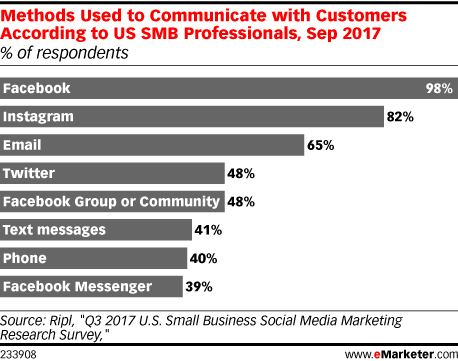Continue with some step to create a social media marketing strategy…
Step 5. Set up accounts and improve existing profiles
Determine which networks to use (and how to use them)
As you decide which social channels to use, you will also need to define your technique for each network.
For instance, Benefit Cosmetics’ social media manager, Angela Purcaro, told eMarketer: “For our makeup tutorials … we are all about Instagram and Snapchat Stories. Twitter, on the other hand, is designated for customer service.”
For reference, right here’s how other small and medium-sized companies are utilizing social tools to communicate with customers. Notice that Instagram and Fb outrank even email for this goal.
It’s a great exercise to make mission statements for each network. These one-sentence declarations will assist you to concentrate on a very particular purpose for each account on each social network.
Example: “We’ll use Fb promoting to target a particular audience in order to improve sales.” One more: “We’ll use Instagram for promoting and sharing our firm culture to help with recruitment and employee advocacy.”
When you cannot create a strong mission statement for a specific social network, you might want to reconsider whether that network is worth it.
Set up (and optimize) your accounts
When you have decided which networks to concentrate on, it’s time to make your profiles—or enhance existing profiles so they align with your strategic plan.
- Ensure you fill out all profile fields
- Use keywords people will use to seek for your business
- Use photos that are correctly sized for each network
Right here’s a quick overview of the way to get your social media profiles into tip-top shape:
Do not let this list overwhelm you. Keep in mind, it’s better to use fewer channels well than to stretch yourself thin attempting to maintain a presence on every network.
Step 6. Find inspiration
While it’s essential that your brand be unique, you could still draw inspiration from other companies which are great on social.
Social network success stories
You could often find these on the enterprise section of the social network’s site. (Here’s Facebook’s, for instance.)
These case studies could offer valuable insights you could apply to your own targets for each social network.
Award-winning accounts and campaigns
You can also take a look at the winners of The Facebook Awards or The Shorty Awards for examples of brands which are at the top of their social media game.
Your favorite brands on social media.
Who do you enjoy following on social media? What do they do that compels people to engage and share their content material?
National Geographic, for instance, is one of the greatest on Instagram, combining stunning visuals with compelling captions.
Then there is Shopify. The e-commerce brand uses Fb to promote themselves by showcasing buyer stories and case studies.
And IKEA is a good instance of superior customer service on Twitter. They use their 280 characters to solve problems and reply questions—usually with a bit of humor.
Notice that each of those accounts has a consistent voice, tone, and style. Consistency is essential to helping your followers understand what to expect from your brand. They will know why they need to continue to follow you and what worth they’ll get from doing so. It also helps keep your branding consistent even when you’ve multiple people working on your social group.
Ask your followers
Consumers may also offer social media inspiration. What are your goal customers talking about online? What could you learn about their needs and wants? When you have existing social channels, you can also ask your existing followers what they need from you. Simply just be sure you observe by way of and ship what they ask for.
Step 7. Create a social media content material calendar
Sharing nice content material is crucial, after all, however, it’s equally vital to have a plan in place for once you’ll share content to get the maximum impact. Your social media content calendar also should account for the time you’ll spend interacting with the viewers (though you should permit for some spontaneous engagement as well).
Create a posting schedule
Your social media content calendar lists the dates and times at which you’ll publish kinds of content on each channel. It’s the perfect place to plan all your social media activities—from photos and link sharing to blog posts and videos. It contains both your day-to-day posting and content material for social media campaigns. Your calendar makes sure your posts are spaced out appropriately and published at the optimal times.
Plot your content mix
Ensure your calendar reflects the mission statement you have assigned to each social profile so that everything you publish is working to assist your business targets. For instance, you may decide that:
- 50 % of content will drive traffic back to your blog
- 25 % of content will be curated from other sources
- 20 % of content will support enterprise targets (selling, lead generation, etc.)
- 5 % of content will be about HR and firm culture
Placing these different post kinds in your content calendar will help make sure you keep the ratio you have planned. When you are starting from scratch and you are simply unsure what kinds of content to publish, try the 80-20 rule:
- 80 % of your posts should inform, educate, or entertain your audience
- 20 % can directly promote your brand.
You can also try the social media rule of thirds:
- One-third of your social content promotes your enterprise, converts readers, and generates revenue.
- One-third of your social content shares ideas and stories from thought leaders in your industry or like-minded businesses.
- One-third of your social content involves personal interactions with your audience.
when you have your calendar set, use scheduling tools or bulk scheduling to arrange your messaging in advance rather than updating constantly throughout the day. This lets you craft the language and format of your posts rather than writing them on the fly whenever you have time.
Step 8. Test, evaluate, and adjust your strategy
Your social media strategy is a hugely necessary doc for your business, and you could not assume you will get it exactly right on the first try. As you begin to implement your plan and track your outcomes, you might find that some methods do not work as well as you’d anticipated, while others are working even better than expected.
Track your data
In addition to the analytics within each social network (see Step 2), you could use UTM parameters to track social guests as they move through your site, so you could see exactly which social posts drive the most traffic to your site.
Re-evaluate, test, and do it all again
Once this data begins coming in, use it to re-evaluate your strategy frequently. You may also use this data to test different campaigns, posts, and strategies against one another. Fixed testing lets you perceive what works and what doesn’t, so you’ll be able to refine your technique in actual time.
Surveys may also be a good way to find out how well your strategy is working. Ask your followers, email list, site visitors whether you are meeting their wants and expectations, and what they would like to see more of. Then ensure that to deliver on what they tell you.
In the social sphere, things change fast. New networks emerge, while others go through significant demographic shifts. Your enterprise will go through periods of change as well. All of which means your social media technique needs to be a living doc that you take a look at frequently and adjust as needed. Refer to it usually to keep you on track, however, do not be afraid to make changes so that it better reflects new targets, tools, or plans.
Once you update your social strategy, ensure that to let everybody on your team know. That method they could all work together to assist your enterprise takes advantage of your social media accounts.


